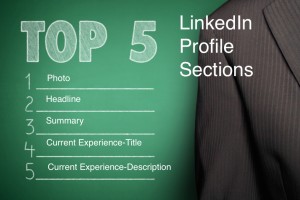Your LinkedIn profile should be like a resume on steroids. In other words, you should go way beyond your one- or two-page traditional resume. You'll want to share lots of relevant information about yourself and your company, and it should  be especially compelling to your target audience.
be especially compelling to your target audience.
I suggest you start with the most important sections of your profile. If you can't answer "yes" to all of the questions below, get busy and beef up your profile with the help of the resources I've provided.
1. Photo. LinkedIn's research says your profile will be viewed 14 times more frequently if you have a photo. Some people will not even connect with a person who doesn't have a photo.
.
- Do you currently look like the person in your photo?
- Is your photo a head shot?
- Are you smiling?
- Are you dressed in your typical workplace attire?
For a more detailed look at the best practices for LinkedIn photos, read "A Professional Photographer's Guide to Getting the Right LinkedIn Profile Photo."
2. Headline. These are the most important 120 characters in your profile. If you don't edit this yourself,  LinkedIn will grab your current job title and company until you take the time to write a dynamic 120-character explanation of who you are and where you're trying to go.
LinkedIn will grab your current job title and company until you take the time to write a dynamic 120-character explanation of who you are and where you're trying to go.
.
- Does your headline clearly state your current business or explain why you're actually on LinkedIn?
- Does your headline include a few of your most important keywords?
- Does your headline encourage people in your target market to want to read more about you?
For additional help with your headline, download my free worksheet "The Definitive Worksheet to Optimize Your LinkedIn Profile Headline."
3. Summary. This section is your virtual cup of coffee with your readers or the cover letter for your job application. You have 2,000 characters to summarize the best stuff on your profile and clearly tell readers where you're trying to go and how they might be able to be part of your journey.
.
- Is your Summary written in the first person?
- Does the first paragraph of your Summary clearly tell me why you're on LinkedIn?
- Does your Summary include several of your most important keywords?
- Does your Summary include at least one call to action for the reader?
For more guidance on improving your Summary, be sure to read Chapter 7 of my book, "The Power Formula for LinkedIn Success."
4. Current Experience - (Job) Title. You're missing a big opportunity if you simply put your official title here. Maximize the 100 characters LinkedIn allows in this section. LinkedIn's search ranking algorithm gives extra weight to the  words in your job titles, and the extra words will increase clarity as well.
words in your job titles, and the extra words will increase clarity as well.
.
- Are your most important keywords in your current job title?
- If you're a salesperson, did you include a few of your products and services?
For additional examples of good job titles, check out my LinkedIn profile.
5. Current Experience - (Job) Description. This section has a 2,000-character limit and should include specifics about your individual position (use keywords) and additional information about the company you work for so the reader clearly understands both of these important points.
.
- Have you included a detailed listing or discussion of your specific job duties and responsibilities and used your most important keywords?
- Have you included specific awards, honors or recognition you have received?
- Did you describe the promotions you've received?
- Have you gotten two recommendations for this job?
For more helpful tips, check out "Does the Experience Section of Your LinkedIn Profile Impress Anyone?"
Make good use of these five important LinkedIn profile sections, and you'll get more exposure than even a top-notch resume can garner.



[…] A few weeks ago I shared with you simple ways to tune up the five most important sections of your profile–photo, headline, summary, current job titles, and job experiences). If you missed those free tips, check them out here. […]